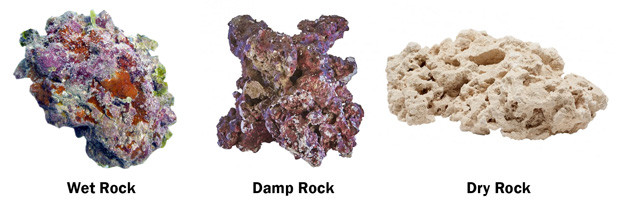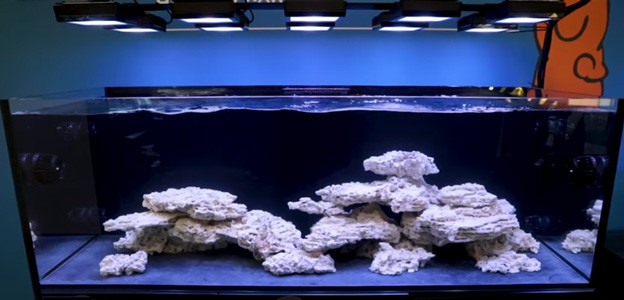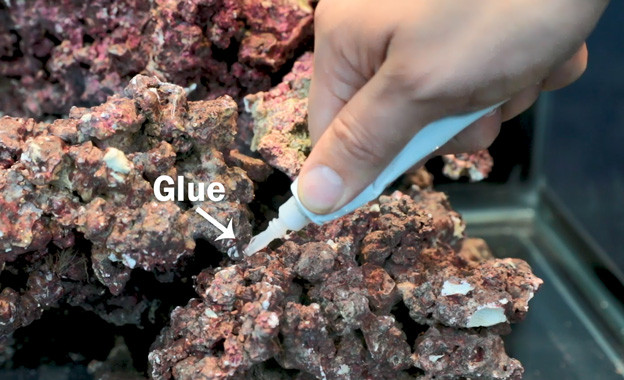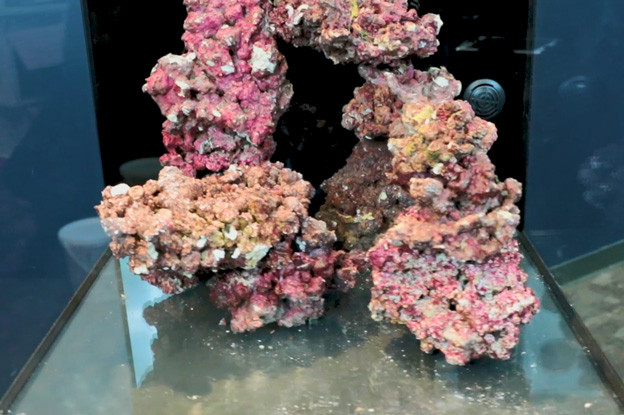Figuring out how much live rock for a 30 gallon tank you need is crucial for a thriving reef aquarium. At rockscapes.net, we understand the importance of creating a balanced ecosystem with the right amount of natural biological filtration. Choosing the correct amount of premium live rock ensures a healthy environment.
1. What Is Live Rock And Why Is It Important?
Live rock isn’t just any rock; it’s rock teeming with beneficial bacteria, algae, and other organisms vital for a saltwater aquarium’s ecosystem. This porous material acts as a natural biological filter, breaking down harmful substances like ammonia and nitrites into less toxic nitrates. Live rock’s biological filtration maintains water quality, essential for the health of your fish and corals.
1.1 The Role Of Beneficial Bacteria
Beneficial bacteria colonize the live rock, forming a complex ecosystem that carries out the nitrogen cycle. The nitrogen cycle is the process where:
- Ammonia, produced by fish waste, is converted to nitrite.
- Nitrite is converted to nitrate.
- Nitrate can be reduced via water changes or denitrification.
1.2 Natural Habitat Creation
Beyond filtration, live rock creates a natural and visually appealing habitat for marine life. Its nooks and crannies provide shelter for fish and invertebrates, while its surface serves as a substrate for coral growth. A well-designed rockscape enhances the aesthetic appeal of your aquarium and supports a diverse ecosystem.
1.3 Types Of Live Rock
Understanding the different types of live rock is crucial for setting up your 30-gallon tank. Each type has its own advantages and disadvantages, impacting the cycling process and the overall health of your aquarium.
- Cured Live Rock: This rock has been pre-cycled and is teeming with beneficial bacteria. It’s the fastest way to establish biological filtration, but can be more expensive and may introduce unwanted hitchhikers.
- Uncured Live Rock: This rock is fresh from the ocean and requires a curing process to remove dead organic matter. It’s less expensive, but requires patience and careful monitoring to avoid ammonia spikes.
- Dry Rock: Dry rock is essentially dead coral skeleton. It’s pest-free and affordable but requires a longer cycling period to become “live.”
- Artificial Live Rock: Man-made and free of pests, artificial live rock offers a sterile alternative. While it won’t introduce beneficial organisms, it provides a substrate for bacteria to colonize.
 Types of live rock
Types of live rock
2. How Much Live Rock Do I Need For A 30 Gallon Tank?
A general rule of thumb is to use 1 to 2 pounds of live rock per gallon of water. Therefore, for a 30 gallon tank, you’ll need approximately 30 to 60 pounds of live rock.
2.1 Factors Affecting Live Rock Quantity
Several factors can influence the ideal amount of live rock for your tank:
- Type of Rock: Denser rock requires less volume than lighter, more porous rock.
- Aquascaping Goals: Intricate designs with caves and arches may require more rock.
- Livestock: Tanks with more fish will need more rock to handle the increased bioload.
- Filtration System: If you have a powerful protein skimmer or refugium, you may need less rock.
2.2 Live Rock Calculation Formula
To accurately determine the amount of live rock for your 30-gallon tank, consider using this formula:
Live Rock (lbs) = Tank Volume (gallons) x Rock Density FactorWhere the Rock Density Factor is:
- Porous Rock: 1.5 – 2.0
- Average Rock: 1.0 – 1.5
- Dense Rock: 0.5 – 1.0
2.3 Overstocking vs. Understocking Live Rock
Finding the right balance is crucial. Overstocking can lead to poor water circulation and dead spots, while understocking may not provide enough biological filtration.
- Overstocking: Can trap detritus, leading to high nitrate levels and potential algae blooms.
- Understocking: May result in inadequate filtration, causing ammonia and nitrite spikes that can harm your livestock.
3. Selecting The Right Type Of Live Rock
Choosing the right type of live rock is crucial for a healthy and thriving 30-gallon tank. Each type offers unique benefits and considerations.
3.1 Cured Live Rock: The Quick Start
Cured live rock has already been through the initial cycling process, making it an excellent choice for those who want to quickly establish a stable environment.
- Pros:
- Faster cycling process
- Established beneficial bacteria
- Immediate biological filtration
- Cons:
- Higher cost
- Potential introduction of pests and parasites
3.2 Uncured Live Rock: The Natural Approach
Uncured live rock is straight from the ocean and needs to be cured before adding it to your main tank.
- Pros:
- More affordable
- More natural biodiversity
- Cons:
- Requires a curing process (3-6 weeks)
- Potential for ammonia spikes
- Risk of introducing unwanted organisms
3.3 Dry Rock: The Safe Bet
Dry rock is essentially dead coral skeleton, free from any living organisms.
- Pros:
- Pest and parasite-free
- More affordable
- Easy to aquascape
- Cons:
- Longer cycling process
- Requires seeding with beneficial bacteria
3.4 Artificial Live Rock: The Modern Option
Artificial live rock is man-made and designed to mimic the look and function of natural live rock.
- Pros:
- Pest and parasite-free
- Consistent shape and size
- Environmentally friendly
- Cons:
- Doesn’t contain natural biodiversity
- Requires seeding with beneficial bacteria
 Reef Saver Rock
Reef Saver Rock
4. Aquascaping Your 30 Gallon Tank
Aquascaping is more than just stacking rocks; it’s about creating a functional and aesthetically pleasing environment for your marine life. The goal is a stable formation that you find visually interesting.
4.1 Planning Your Design
Before you start, sketch out your desired aquascape. Consider the following:
- Fish Behavior: Research the natural habitats of your fish and create similar environments.
- Coral Placement: Plan for future coral growth and ensure adequate lighting and flow.
- Water Flow: Ensure good water circulation throughout the tank to prevent dead spots.
4.2 Aquascaping Tips And Tricks
- DON’T stack rocks higher than ⅔ of the tank height.
- DON’T create a rock pile or mound in the middle.
- DO create peaks, valleys, overhangs, arches, and caves.
- DO remember that you are creating a habitat for fish and invertebrates, and many of them need places to hide.
- DO ensure your aquascape is stable.
4.3 Ensuring Stability
Use reef-safe glue or epoxy to secure the rocks together. This will prevent collapses and protect your livestock. Cyanoacrylate gel is ideal because it dries clear.
 Ryan using reef glue to secure rocks together
Ryan using reef glue to secure rocks together
4.4 Creating Hiding Places
Provide plenty of hiding places for your fish and invertebrates. Caves, arches, and overhangs create a sense of security and reduce stress.
4.5 Allowing For Water Flow
Ensure that water can flow freely around and through your rock structure. This will prevent detritus buildup and promote healthy oxygen levels.
5. Cycling Your 30 Gallon Tank With Live Rock
Cycling is the process of establishing a biological filter in your aquarium. It involves the development of beneficial bacteria that convert harmful ammonia and nitrites into less toxic nitrates.
5.1 The Nitrogen Cycle Explained
- Ammonia Production: Fish waste and decaying organic matter produce ammonia (NH3), which is highly toxic to marine life.
- Nitrification: Beneficial bacteria (Nitrosomonas) convert ammonia into nitrite (NO2-), which is still toxic but less so than ammonia.
- Nitration: Different bacteria (Nitrobacter) convert nitrite into nitrate (NO3-), which is much less toxic and can be removed through water changes.
5.2 Monitoring Water Parameters
Regularly test your water parameters using a reliable test kit. Monitor ammonia, nitrite, nitrate, and pH levels.
- Ammonia and Nitrite: Should be at 0 ppm once the cycle is complete.
- Nitrate: Should be kept below 20 ppm through regular water changes.
- pH: Should be maintained between 8.1 and 8.4.
5.3 The Cycling Process Step-By-Step
- Set Up Your Tank: Place your live rock and substrate in the tank.
- Fill With Saltwater: Use a high-quality saltwater mix and ensure the salinity is correct.
- Add an Ammonia Source: Introduce a small amount of ammonia to start the cycle.
- Monitor Water Parameters: Test daily for ammonia, nitrite, and nitrate.
- Wait for the Cycle to Complete: The cycle is complete when ammonia and nitrite levels are consistently at 0 ppm, and nitrate levels are detectable.
- Perform a Water Change: Do a 25% water change to reduce nitrate levels before adding livestock.
5.4 Speeding Up The Cycling Process
- Use Cured Live Rock: Cured live rock already contains established bacteria colonies.
- Add a Bacteria Supplement: Commercial bacteria supplements can help kickstart the cycling process.
- Maintain Proper Temperature: Keep the water temperature between 78-82°F (25-28°C).
- Provide Oxygen: Ensure good water circulation and aeration.
6. Maintaining Your Live Rock
Proper maintenance of your live rock is essential for the long-term health of your aquarium.
6.1 Regular Water Changes
Perform regular water changes (10-20% weekly) to remove nitrates and replenish trace elements.
6.2 Avoiding Overfeeding
Overfeeding can lead to excess nutrients and algae growth. Feed your fish only what they can consume in a few minutes.
6.3 Cleaning Detritus
Use a siphon to remove detritus from the substrate and around the base of the live rock.
6.4 Maintaining Proper Water Flow
Ensure good water circulation to prevent detritus buildup and promote healthy oxygen levels.
6.5 Controlling Algae Growth
Algae growth is normal, but excessive growth can indicate nutrient imbalances. Use algae-eating snails and crabs to control algae levels.
7. Common Mistakes To Avoid With Live Rock
Avoiding common mistakes can save you time, money, and heartache.
7.1 Adding Too Much Live Rock At Once
Adding too much uncured live rock at once can cause a massive ammonia spike, overwhelming your biological filter.
7.2 Neglecting Water Changes
Neglecting water changes can lead to high nitrate levels and poor water quality.
7.3 Overstocking Your Tank Too Soon
Wait until the tank is fully cycled before adding livestock. Adding fish or corals too soon can disrupt the cycling process and harm your new additions.
7.4 Not Quarantining New Additions
Quarantine new fish and invertebrates before adding them to your main tank. This will prevent the introduction of diseases and parasites.
7.5 Using Tap Water
Always use RODI (reverse osmosis deionized) water for your aquarium. Tap water can contain harmful chemicals and pollutants.
8. The Aesthetic Benefits Of Live Rock
Beyond its functional role, live rock significantly enhances the aesthetic appeal of your aquarium.
8.1 Creating Natural Reefscapes
Live rock allows you to create realistic and visually stunning reefscapes. Its natural textures and shapes mimic the beauty of a natural coral reef.
8.2 Enhancing Fish Behavior
A well-designed rockscape provides fish with a sense of security and encourages natural behaviors. Fish will explore, hunt, and hide among the rocks, adding to the visual interest of your tank.
8.3 Supporting Coral Growth
Live rock provides a natural substrate for coral growth. Corals will attach to the rock and thrive, creating a vibrant and colorful display.
 Red Sea E-170 with Real Reef Rock
Red Sea E-170 with Real Reef Rock
9. Integrating Live Rock With Other Filtration Methods
Live rock works best when combined with other filtration methods.
9.1 Protein Skimmers
Protein skimmers remove organic waste before it breaks down, reducing the bioload on your live rock.
9.2 Refugiums
Refugiums are separate tanks or compartments that house macroalgae and invertebrates. They help to reduce nitrates and provide a habitat for beneficial organisms.
9.3 Media Reactors
Media reactors use specialized media to remove specific pollutants, such as phosphate or nitrate.
9.4 Water Changes
Regular water changes are essential for removing nitrates and replenishing trace elements, even with other filtration methods in place.
10. Where To Buy Quality Live Rock
Choosing a reputable supplier is essential for obtaining high-quality live rock.
10.1 Local Fish Stores
Local fish stores (LFS) offer the advantage of seeing the rock in person before you buy it. You can also get advice from experienced aquarists.
10.2 Online Retailers
Online retailers offer a wider selection of live rock and often have competitive prices. Be sure to read reviews and choose a reputable vendor.
10.3 Rockscapes.net
At rockscapes.net, we offer a wide variety of high-quality live rock to meet your specific needs. Our rock is carefully selected and cured to ensure optimal performance.
10.4 Questions To Ask Your Supplier
- What type of rock is it?
- Is it cured or uncured?
- Where did it come from?
- How was it stored and transported?
- What is your guarantee?
11. The Future Of Live Rock In Reef Aquariums
The future of live rock in reef aquariums is evolving.
11.1 Sustainable Alternatives
As concerns about the environmental impact of harvesting live rock grow, more sustainable alternatives are being developed, such as cultured live rock and artificial rock.
11.2 Advances In Bacteria Supplements
Advances in bacteria supplements are making it easier to cycle tanks and maintain healthy biological filtration without relying solely on live rock.
11.3 Hybrid Approaches
Many aquarists are adopting hybrid approaches that combine live rock with other filtration methods and sustainable alternatives.
12. Legal and Ethical Considerations for Live Rock
Harvesting live rock can have a significant impact on marine ecosystems. It’s essential to be aware of the legal and ethical considerations involved.
12.1 Regulations and Restrictions
Some regions have strict regulations or bans on the harvesting of live rock. Be sure to check local laws before purchasing live rock.
12.2 Sustainable Sourcing
Choose suppliers who source their live rock sustainably. Sustainable harvesting practices minimize damage to coral reefs and ensure the long-term health of marine ecosystems.
12.3 Supporting Conservation Efforts
Support organizations that are working to protect coral reefs and promote sustainable aquarium practices.
13. Addressing Common Live Rock Problems
Even with proper care, you may encounter problems with your live rock.
13.1 Hitchhikers
Live rock can introduce unwanted hitchhikers, such as pests, parasites, and nuisance algae.
- Prevention: Quarantine new live rock in a separate tank to observe for any unwanted organisms.
- Treatment: Manually remove pests, use chemical treatments, or introduce natural predators.
13.2 Algae Blooms
Algae blooms can occur due to excess nutrients or poor water quality.
- Prevention: Maintain proper water parameters, avoid overfeeding, and ensure adequate water flow.
- Treatment: Perform water changes, use algae-eating snails and crabs, and consider using a phosphate remover.
13.3 Dead Spots
Dead spots can occur in areas with poor water circulation, leading to detritus buildup and anaerobic conditions.
- Prevention: Ensure adequate water flow throughout the tank.
- Treatment: Rearrange the rockwork to improve circulation, and use a siphon to remove detritus.
14. DIY Live Rock: Is It Possible?
Creating your own live rock is possible, though it requires time and effort.
14.1 Materials Needed
- Dry rock or concrete
- Aragonite sand
- Live rock rubble
- Saltwater
- Container for curing
14.2 The Process
- Create a Rock Structure: If using concrete, create a rock-like structure and allow it to cure completely.
- Seed the Rock: Place the rock in a container with saltwater, aragonite sand, and live rock rubble.
- Cure the Rock: Allow the rock to cure for several weeks, performing regular water changes.
- Monitor Water Parameters: Test the water regularly for ammonia, nitrite, and nitrate.
- Add to Your Tank: Once the rock is fully cycled, it can be added to your main tank.
14.3 Pros and Cons
- Pros: Cost-effective, pest-free, customizable.
- Cons: Time-consuming, requires monitoring, may not be as effective as natural live rock.
15. Case Studies: Successful 30-Gallon Reef Tanks
Examining successful 30-gallon reef tanks can provide valuable insights and inspiration.
15.1 Case Study 1: A SPS-Dominated Tank
This tank features a minimalist aquascape with high flow and intense lighting to support the growth of small polyp stony (SPS) corals.
- Live Rock: 35 pounds of porous live rock
- Filtration: Protein skimmer, media reactor, regular water changes
- Livestock: SPS corals, small fish
15.2 Case Study 2: A Mixed Reef Tank
This tank features a more diverse aquascape with a variety of soft corals, large polyp stony (LPS) corals, and fish.
- Live Rock: 45 pounds of mixed density live rock
- Filtration: Refugium, protein skimmer, regular water changes
- Livestock: Soft corals, LPS corals, small fish, invertebrates
15.3 Key Takeaways
- Proper planning is essential for a successful reef tank.
- The right amount of live rock is crucial for biological filtration.
- Combining live rock with other filtration methods is beneficial.
- Regular maintenance is essential for long-term success.
16. FAQ: Live Rock for 30 Gallon Tanks
Here are some frequently asked questions about using live rock in a 30-gallon tank:
16.1 Can I use too much live rock in my 30-gallon tank?
Yes, overstocking live rock can lead to poor water circulation, detritus buildup, and anaerobic conditions.
16.2 How long does it take for live rock to cycle a tank?
The cycling process can take anywhere from 2 to 8 weeks, depending on the type of rock and the conditions in the tank.
16.3 Can I clean live rock?
Yes, you can gently brush or rinse live rock to remove detritus and algae. Avoid using soap or harsh chemicals.
16.4 What is the best way to aquascape live rock?
Plan your design in advance, use reef-safe glue or epoxy to secure the rocks, and create plenty of hiding places for your fish.
16.5 How often should I do water changes in my 30-gallon reef tank?
Perform water changes of 10-20% weekly to maintain proper water quality.
16.6 Can I add fish before the tank is fully cycled?
No, wait until the tank is fully cycled before adding fish to avoid ammonia and nitrite poisoning.
16.7 What are some signs of unhealthy live rock?
Signs of unhealthy live rock include foul odors, excessive algae growth, and the presence of dead or decaying organisms.
16.8 Can I use dry rock instead of live rock?
Yes, dry rock is a good alternative to live rock, but it requires a longer cycling process.
16.9 How can I prevent pests and parasites from entering my tank with live rock?
Quarantine new live rock in a separate tank to observe for any unwanted organisms.
16.10 What are the best types of fish for a 30-gallon reef tank?
Good choices for a 30-gallon reef tank include clownfish, gobies, blennies, and other small, peaceful species.
17. Expert Insights on Live Rock
According to research from Arizona State University’s School of Earth and Space Exploration, healthy live rock contributes significantly to maintaining stable pH levels in reef aquariums due to the buffering capacity of the calcium carbonate substrate. This stability is crucial for the survival and growth of corals and other invertebrates.
18. Final Thoughts: Creating Your Perfect Reef
Figuring out How Much Live Rock For 30 Gallon Tank you need is an important step in creating a thriving reef aquarium. By understanding the role of live rock, selecting the right type, and following proper maintenance procedures, you can create a beautiful and healthy environment for your marine life.
Ready to start your reef tank journey? Visit rockscapes.net for inspiration, information, and high-quality live rock to help you create the reef of your dreams. Contact us at 1151 S Forest Ave, Tempe, AZ 85281, United States or call +1 (480) 965-9011 for expert advice and personalized recommendations. We’re here to help you every step of the way.
